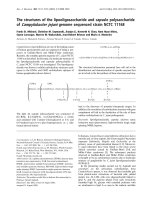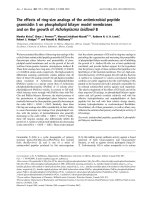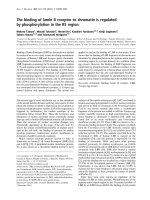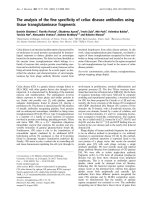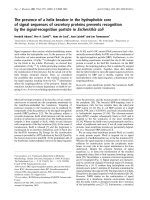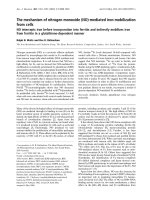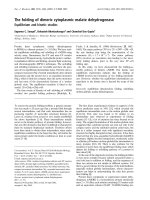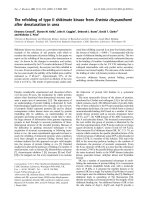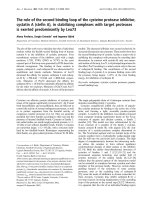Báo cáo Y học: The function of methyl-menaquinone-6 and polysul®de reductase membrane anchor (PsrC) in polysul®de respiration ofWolinella succinogenes doc
Bạn đang xem bản rút gọn của tài liệu. Xem và tải ngay bản đầy đủ của tài liệu tại đây (477.99 KB, 10 trang )
The function of methyl-menaquinone-6 and polysul®de reductase
membrane anchor (PsrC) in polysul®de respiration
of
Wolinella succinogenes
Wiebke Dietrich and Oliver Klimmek
Institut fu
È
r Mikrobiologie, Johann Wolfgang Goethe-Universita
È
t, Frankfurt am Main, Germany
Wolinella suc cinogenes grows by oxidative phosphorylation
with polysul®de as terminal electron a cceptor and either H
2
or formate a s electron donor (polysul®de respiration). The
function of the respiratory chains catalyzing these reactions
was i nvestigated. Proteoliposomes containing polysul®de
reductase (Psr) and either hydrogenase or formate dehy-
drogenase i solated f rom the membrane fraction of Wolinella
succinogenes catalyzed polysul®de respiration, provided that
methyl-menaquinone-6 isolated from W. succinogenes was
also present. The speci®c activities of electron transport were
commensurate with those of the bacterial membrane frac-
tion. Using site-directed mutage nesis, certain residues were
substituted in P srC, t he membrane a nchor of polysul®de
reductase. Replacement of Y23, D76, Y159, D218, E225 or
R305 caused nearly full inhibition of polysul®de respiration
without aecting the activity of Psr, which was still bound to
the membrane. These residues are predicted to be located in
hydrophobic helices o f PsrC, or n ext to t hem. Substitution o f
13 other r esidues of PsrC e ither c aused p artial inh ibition
of polysul®de respiration or had no eect. The function of
methyl-menaquinone-6, which is thought to be bound to
PsrC, is discussed.
Keywords: methyl-menaquinone; polysul®de respiration;
sulfur respiration; hydrogenase; formate dehydrogenase.
Wolinella succinogenes grows at the expense of polysul®de
([S]) respiration with H
2
[reaction (a)] or formate [reaction
(b)] as electron donor [1±3]. Reactions (a) (DG
o
¢ A31
kJámol H
À 1
2
)and(b)(DG
o
¢A30 kJ mol
A1
formate) are
coupled to the generation of an electrochemical proton
potential (Dp 0.17 V) across the bacterial membrane
which drives ATP synthesis [3±6].
H
2
+[S] ® HS
±
+H
+
(a)
HCO
2
±
+[S] ® CO
2
+HS
±
(b)
It was proposed that the electron transport chain catalyz-
ing reactions (a) or (b) consisted of the membrane bound
components polysul®de reductase (Psr) and either h ydro-
genase or formate dehydrogenase [3,6±10]. The catalytic
subunits of the three enzymes are orien ted to t he periplasmic
side of the m embrane [4,6,10,11]. The three enzymes were
isolated from the membrane fraction of W. succinogenes
[3,6±8,12,13], and the corresponding genes were sequenced
[9,12,14]. Hydrogenase (Hyd) and formate dehydrogenase
(Fdh) are identical with the enzymes involved in fumarate
respiration with H
2
and f ormate in W. succinogenes [7,8,15].
The cytochrome b subunits of the two enzymes ( HydC and
FdhC) which carry the sites of quinone reduction are similar.
Their four histidine residues c oordinating the two heme B
groups are predicted to be located at similar places on three
homologous membrane helices.
Proteoliposomes containing Psr and either hydrogenase or
formate dehydrogenase were reported to catalyze reaction (a)
or (b) [4,6±8]. The electron transport activities amounted to
maximally 5 % of those measured in the bacterial membrane
fraction. The activities were not higher in proteoliposomes
additionally containing vitamin K
1
which is known to
substitute for menaquinone in fumarate respiration.
The isolated Psr was found to consist of the three subunits
predicted by the psrABC operon [3,6,8]. It contained
molybdenum (1 mol per mol enzyme), molybdopterine
guanine d inucleotide, free i ron and sul®de, and menaqui-
none. Heme, ¯avin and other heavy metals were absent. The
enzyme catalyzed the reduction of polysul®de by BH
4
±
[reaction (c)] and the oxidation of sul®de by 2,3-dimethyl-
1,4-naphthoquinone (DMN) [reaction (d)].
BH
4
±
+[S] ® BH
3
+HS
±
(c)
HS
±
+ DMN + H
+
® [S] + DMNH
2
(d)
PsrA is similar to the catalytic subunits of several
molybdo-oxidoreductases and is probably the catalytic
subunit of Psr, which carries molybdenum coordinated by
molybdopterin guanine dinucleotide. PsrA and PsrB are
predicted to carry one and four iron-sulfur-centers, respec-
tively. PsrC is a hydrophobic p rotein which anchors the
enzyme in the membrane [10].
Correspondence to O. Klimme k, Institut fu
È
r Mikrobiologie, Johann
Wolfgang Goethe-Universita
È
t, Marie-Curie-Str. 9, D-60439 Frankfurt
am Main, Germany. Fax: + 49 6 9 79829527,
Tel. + 49 69 79829509, E-mail:
Abbreviations: DMN, 2,3-dimethyl-1,4-naphthoquinone; Hyd,
hydrogenase; Fdh, formate dehydrogenase; MK, menaquinone; MK
6
,
menaquinone with a side chain o f six isoprene units; MM, 5- or
8-methyl-MK
6
;MM
b
,MMboundtoPsrC;MM
b
H
±
, quinol anion of
MM bound to PsrC; Ps r, polysul®de reductase; [S], sulfur atom in
polysul®de; TTFB, 4,5,6,7-tetrachloro-2-tri¯uoromethyl-
benzimidazol;
Dp, electrochemical proton potential across a membrane; Dw, e lectric
term of Dp; Ttr, tetrathionate reductase.
(Received 25 J une 2001, revised 1 November 2001, accepted
7 November 2001)
Eur. J. Biochem. 269, 1086±1095 (2002) Ó FEBS 2002
When the membrane f raction o f W. succinogenes was
fused to liposomes containin g menaquinone isolated from
W. succinogenes, the electron transport a ctivities [reactions
(a) and (b)] decreased as a function of the degree of dilution
of the m embrane proteins by phospholipid [6,16]. This
effect was interpreted to indicate that the electron transfer
from the dehydrogenases to Psr requires diffusion and
collision of the enzyme molecules within the membrane.
Consistent with this interpretation, the electron transport
activity with fumarate was not decreased upo n dilution of
the membrane p roteins. In this case the elec tron transfer
from the dehydrogenases to fumarate reductase is accom-
plished by m enaquinone (MK) whose diffusion velocity i s
two orders of m agnitude higher than that of the much
larger enzymes.
When the membrane fraction was fused t o liposomes
containing either no quinone or vitamin K
1
instead of
menaquinone from W. succinogenes, the activities of poly-
sul®de resp iration d ecreased more markedly as t he phos-
pholipid content increased [6,16]. This suggested that one of
the two menaquinones of W. succinogenes was speci®cally
required for polysul®de respiration a nd could not be
substituted by vitamin K
1
.
Here we report on our attempts to r estore polysul®de
respiration in liposomes using one of the menaquinones of
W. succinogenes. To elucidate the function of PsrC, w hich is
thought to bind quinone, certain amino-acid residues of t his
subunit w ere replaced using site-directed mutagenesis. The
resulting mutants were characterized by measuring their
speci®c a ctivities of polysul®de respiration [reactions (a) and
(b)] and of Psr [reactions (c) and (d)]. The mechanism of
polysul®de respiration is discussed in the light of the
experimental results.
MATERIALS AND METHODS
Growth of
W. succinogenes
W. succinogenes was grown with formate as electron donor
and either fumarate or nitrate as electron acceptor as
described previou sly [17,18]. The medium containing nitrate
was supplemented with b rain±heart infusion (1,3% w/v;
Gibco BRL). Kanamycin (25 mgáL
A1
) and chloramphen icol
(12,5 mgáL
A1
) were added to the medium when indicated.
Cell fractionation
Cells of W . succinogenes grown with fumarate w ere sus-
pended (10 g proteináL
A1
)in50m
M
Tris/HCl, pH 8.0 at
0 °C. The suspension was passed through a French press at
130 Mpa and 10 mLámin
A1
¯ow. The resulting cell homo-
genate was centrifuged for 40 min at 100 000 g to yield the
soluble cell fraction (supernatant) and the membrane
fraction. The membrane fraction was r esuspended in the
same buffer (10 g proteináL
A1
).
SDS/PAGE, Western blotting and ELISA
SDS/PAGE was carried out according t o [19]. Protein was
transferred to nitrocellulose sheets b y electro blotting in a
discontinuous buffer system [20]. PsrA was visualized by
indirect ELISA u sing the corresponding antiserum and goat
anti-(rabbit IgG) Ig conju gated to peroxidase [9].
Fusion particles and proteoliposomes
Sonic liposomes containing quinone were prepared from a
mixture of egg phospholipid (95%, w/w) [21] and phospha-
tidylethanolamine (5%, Fluka; cat. no. 60650) as described
previously [13,22]. Fusion particles (see below) were pre-
pared by freeze±thawing a mixture of sonic liposomes
containing 5- or 8-methyl-MK
6
(MM) and bacterial mem-
brane f raction [16]. Th e fusion p articles contained e qual
amounts of phospholipid from the liposomes and from the
membrane fraction.
Proteoliposomes were prepared by freeze-thawing sonic
liposomes containing the quinone indicated (Table 1;
10 lmolág phospholipid
A1
) with Psr (or fumarate reductase)
and either hydrogenase or formate dehydrogenase [8,13,22].
Per g phospholipid, a total of 26 nmol Psr, 31 nmol
fumarate reductase, 1 78 nmol hydrogenase and 89 nmol
formate dehydrogenase were applied.
Quinones
MK
6
and MM were extracted from the membrane fraction
of W. succinogenes grown with fumarate using a mixture o f
petrol ether a nd methanol. The quinones in the e xtract were
separated by H PLC according to [23]. The quinones were
quanti®ed by HPLC using vitamin K
1
as the s tandard. MK
4
(Sigma; c at. no. V-937 8) and v itamin K
1
(Fluka; cat. no.
95271) are commercially available.
Activities of Psr and of polysul®de respiration
The activity of Psr was measured at 37 °C by photometric
recording of polysul®de reduction with BH
4
±
[24] or by
photometric recording of DMN reduction with sul®de [2].
Polysul®de respiration with H
2
or formate (electron trans-
port) was recorded photometrically at 37 °C as de scribed
previously [2,8,16]. The unit of activity (U) correspo nded to
consumption of 1 lmol substrate per min.
Protein
Protein was determined after precipitation with t richloro-
acetic acid using the Biuret method with KCN [25].
Table 1. A ctivities o f p olysul®de r espiration of proteoliposomes con-
taining dierent naphthoquinones. Polysul®de respiration with H
2
(H
2
® [S]) or with formate (HCO
2
±
® [S]) was m easured in prote-
oliposomes containing Psr and either hydrogenase or formate
dehydrogenase isolated from W. succinogenes. Fumarate respiration
with formate (HCO
2
® fumarate) was measured in proteoliposomes
containing f umarate reductase a nd formate dehydrogenase as
described previously [22]. The activities are given as substrate turnovers
of Psr or fumarate reductase at 37 °C. All values are in units of s
A1
.
Quinone H
2
® [S] HCO
2
±
® [S] HCO
2
±
® fumarate
±25517
Methyl-MK
6
(MM) 370 175 35
MK
6
27 5 1490
MK
4
34 7 1455
VitK
1
25 5 1180
Ó FEBS 2002 Polysul®de respiration of W. succinogenes (Eur. J. Biochem. 269) 1087
Genetic techniques
Standard genetic procedures were used essentially
according to [26]. DNA was isolated from W. succino-
genes with the DNeasy Tissue Kit from Qiagen. PCR
was carried out using the Expand High Fidelity
PCR System (Roche) or the Expand Long Template
PCR System (Roche) with standard ampli®cation proto-
cols and a Hybaid Omnigene Thermocycler (MWG
Biotech). Southern blotting to nylon membranes was
performed as described previously [27]. DNA probes
were generated with the PCR DIG Probe Synthesis K it
(Roche), and hybrids were visualized using the DIG/
Luminescent Detection Kit (Roche).
Construction of
W. succinogenes
KpsrC
Mutant KpsrC was constructed by integrating plasmid
pKpsrC into the genome of mutant DpsrC [10] (Fig. 1).
Plasmid pKpsrC was constructed from pT7-6 [28] by
inserting the cat
GC
gene excised from pDF4a [29] using
BamHI restriction. The orientation of cat
GC
was con®rmed
by restriction analysis. Subsequently, a fragment comprising
most of psrB (521 bp), psrC, a nd 60 bp of the 3¢ end of rhpR
was inserted using HindIII and Xb aI. This fragment was
synthesized from genomic DNA by PCR with primers
carrying at their 5¢ ends suitable restriction sites for cloning.
The identity of the cloned PCR fragment was c on®rmed by
sequencing.
Cells of W. succinogenes DpsrC were transformed with
the plasmid as described previously [30]. Transformants
were selected on agar plates containing the nitrate
medium, 2.6% (w/v) brain-heart-infusion agar (Gibco
BRL) and chloramphenicol (12.5 mgáL
A1
). The genome
of several transformants was checked for t he presence of
the cat
GC
and the psrC gene by means of Southern blot
analysis using Bgl II restriction (Fig. 1). As expected, only
one BglII fragment (9.7 kbp) of mutant KpsrC
hybridized to the cat
GC
and the psrC probe. The
in-frame integration of the plasmid was con®rmed by
sequencing.
Construction of
W. succinogenes
psrC mutants
The psrC mutants of W. succinogenes (see Table 2) were
constructed by t ransforming W. succinogenes DpsrC with
derivatives of pKpsrC. The derivatives were synthesized
using the Quick Change site-directed mutagenesis kit
(Stratagene) with pKpsrC as template and speci®cally
synthesized oligonucleotides carrying the desired nucleotide
mismatches. Modi®ed pKpsrC plasmids were sequenced to
con®rm the m utations. Transformation o f W. succinogenes
DpsrC with modi®ed plasmids and selection of t ransfor-
mants was performed as described above.
Computer analysis
Database searches made use of the program
BLAST
[31].
Search for membrane-spanning helices was performed using
the
TMPRED
program [32]. Multiple sequences were aligned
using the program
CLUSTALW
[33].
RESULTS
Reconstitution of polysul®de respiration
W. succinogenes grown w ith polysul®de or with fumarate
catalyzes polysul®de respiratio n [reactions (a) and (b)] as
well as fumarate respiration with H
2
or formate [16]. These
bacteria contain equal amounts (approximately 3 lmol p er
g phospholipid) of MK
6
and o f MM [34]. The methyl group
in the a romatic ring o f MM is at position 5 or 8. Like MK,
MM appears to be d issolved in the lipid phase of the
membrane and is not tightly bound to membrane proteins.
Both quinones can be extracted from t he membrane with a
mixture of petrol ether and methanol.
In the experiment shown in Table 1, Psr and either
hydrogenase or formate dehydrogenase were incorporated
into liposomes containing one of the quinones indicated
(10 lmolág phospholipid
A1
). The activities of polysul®de
respiration of p roteoliposomes containing MM were more
than an order of magnitude greater than of those p repared
with MK
6
,MK
4
, vitamin K
1
, or w ithout quinone. These
Fig. 1. P hysical map of the psr locus of W. succinogenes DpsrC and KpsrC. Mutant KpsrC was obtained by integration of pKpsrC into the genome
of the DpsrC mutant.
1088 W. Dietrich and O. Klimmek (Eur. J. Biochem. 269) Ó FEBS 2002
Table 2. P roperties of psrC mutants grown with formate and fumarate. The presence o f PsrA was tested by Western blot and E LISA. The speci®c
activities of Psr (BH
4
±
® [S] a nd HS
±
® DMN) and of polysul®de respiration (H
2
® [S] and HCO
2
±
® [S]) refer to total cellular protein (cells)
or to the protein of the membrane fraction ( MF).
Strain Preparation
PsrA
present
Uámg protein
A1
BH
4
±
® [S] HS
±
® DMN H
2
® [S] HCO
2
±
® [S]
Wild-type Cells 13 6.7 2.1 1.8
MF + 19 14 1.5 1.1
DpsrC Cells +
a
12 7.0 £ 0.01 £ 0.01
MF ± £ 0.1 £ 0.1 £ 0.01 £ 0.01
KpsrC Cells 8.1 5.5 2.2 1.2
MF + 16 9.8 0.9 1.0
W16F Cells + 1.7 1.6
MF 17 9.7 0.6 0.5
Y23F Cells 0.04 0.03
MF + 13 11 0.02 0.03
D76N Cells £ 0.01 £ 0.01
MF + 20 7.2 0.02 0.02
D76H Cells 0.21 0.11
MF + 19 8.3 0.20 0.09
D76L Cells 0.02 £ 0.01
MF + 19 7.9 0.03 0.02
H82A Cells 2.3 1.1
MF + 17 10 1.4 0.6
S94A Cells 1.6 1.1
MF + 13 7.0 0.8 0.8
Y106F Cells 1.8 1.4
MF + 19 9.3 0.8 0.7
E146Q Cells 1.8 1.0
MF + 14 4.6 0.6 0.4
Y159F Cells £ 0.01 £ 0.01
MF + 12 7.0 0.02 0.02
T160V Cells 0.2 0.2
MF + 17 9.3 0.1 0.1
N174D Cells 1.4 1.2
MF + 17 11 0.9 0.8
S185A Cells 0.9 0.8
MF + 12 6.0 0.4 0.4
S188A Cells 0.5 0.5
MF + 11 5.1 0.2 0.2
S192A Cells 2.1 1.7
MF + 19 11 0.8 0.7
E209Q Cells 2.3 2.1
MF + 19 13 1.2 1.1
D218N Cells £ 0.01 £ 0.01
MF + 15 7.9 0.02 0.02
E225Q Cells 0.03 0.03
MF + 11 4.9 0.03 0.03
E225D Cells 1.1 1.2
MF + 14 7.8 0.4 0.7
W261F Cells 2.0 1.3
MF + 21 10 0.7 0.6
R305F Cells 0.04 0.07
MF + 13 7.2 0.02 0.02
R305K Cells £ 0.01 0.02
MF + 19 7.9 0.03 0.04
Y310F Cells 1.6 1.3
MF + 17 14 1.0 1.2
a
The cell homogenate was used.
Ó FEBS 2002 Polysul®de respiration of W. succinogenes (Eur. J. Biochem. 269) 1089
low a ctivities were probably due to the low level of MM
present in the enzyme preparations used for preparing the
proteoliposomes. Proteoliposomes prepared with fumarate
reductase and formate dehydrogenase c atalyzed fumarate
respiration with formate at high activities, i f MK
6
,MK
4
or
vitamin K
1
were also incorporated. However, if MM was
incorporated instead, the activity was as low as that o f
proteoliposomes p repared w ithout added quinone. I n
liposomes containing fumarate reductase and hydrogenase,
fumarate respiration with H
2
was restored by MK
6
,MK
4
or
vitamin K
1
but not by MM (data not shown).
The turnover number of Psr in polysul®de respiration
with formate in the proteoliposomes is close to that
measured in the membrane fraction o f w ild-type W. suc-
cinogenes (see Table 2) w hich contains approximately
0.1 lmol Psr per g membrane protein [3,8]. The turnover
number with H
2
is 50% higher i n the proteoliposomes than
in the membrane fraction. This higher a ctivity is p robably
due to the higher a mount of hydro genase relative to Psr in
the proteoliposomes. In summary, functional electron
transport chains catalyzing reactions (a) or (b) at the
expected activities can be restored from the isolated enzymes
and MM. Hence no further components appear to be
required for the electron transport. MM is speci®cally
involved in polysul®de respiration and cannot be substituted
by MK
6
although this is also present in the membrane of
W. succinogenes.
In the experiment shown in Fig. 2, t he membrane fraction
of W. succinogenes was fused with sonic liposomes contain-
ing i ncreasing amounts of MM. The six d ifferent prepara-
tions so obtained contained equal amounts of phospholipids
from the membrane f raction and from the liposomes. The
activity of polysul®de respiration with H
2
increased hyper-
bolically with the amount of MM. The activity was 50 a nd
80% of the maximum activity with 2.5 and 10 lmol MM
per g phospholipid, respectively. Thus the activity is
considerably enhanced by the incorporation of additional
MM into the membrane f raction which normally contains
approximately 3 lmol MM p er g phospholipid. As noted
in the Discussion section, the titration curve (Fig. 2)
may re¯ect binding of reduced MM to PsrC. If this
assumption is valid, the dissociation constant would be
2.5 lmol MMág phospholipid
A1
.
The effect of D
p
on the electron transport activity
The speci®c activities of Psr in the membrane fraction are
about twice those found in cells of W. succinogenes (see
Table 2). This is consistent with the location of Psr in the
membrane which contains half of the total cellular protein.
In contrast, the speci®c activities of polysul®de respiration
are higher in cells than in the membrane fraction (see
Table 2). This is probably due to the Dp generated across
the membrane of cells by p olysul®de respiration [5]. The Dp
is lost upon cell disruption. The addition of a protonophore
to cells also caused inhibition of polysul®de respiration
(Fig. 3 ). The protono phore 4 ,5,6,7-tetrachloro-2-tri¯uoro-
methylbenzimidazol (TTFB) which i s known t o dissipate
the Dp [5,35] was found to cause up to 70% inhibition of
polysul®de respiration in c ells. Polysul®de respiration in the
membrane fraction or fumarate respiration in cells or in the
membrane fraction were not inhibited by TTFB (not
shown). Thus, the activity of polysul®de respiration appears
to be stimulated by Dp.
Characterization of psrC mutants
PsrC is predicted to form eight membrane-spanning helices
and to be s imilar to four hydrophobic subunits of other
electron transport enzymes which are likely to react
with quinones (Fig. 4). The nrfD genes of E. coli and
Haemophilus in¯uenzae are constituents of gene clusters
encoding Ôcytochrome c nitrite reductaseÕ.NrfAofE. coli is
known to b e the catalytic subunit of this enzyme [37]. The
gene product of nrfD was proposed to encode the m embrane
anchor of the enzyme and to carry the site of quinol
oxidation. Tetrathionate reductase (Ttr) of Salmonella
typhimurium is thought to catalyze the reduction of
Fig. 2. A ctivity of polysul®de respiration with H
2
as a function of the
MM content o f fusion particles. The maximum activity was assumed to
be measured with 57 lmo l MMág pho spho lipid
-1
.
Fig. 3. T he e ect of the protonophore TTFB o n the activities of poly-
sul®de respiration in cells of W. succinogenes. TTFB dissolved in
demethylsulfoxide was added 3 min before the electron transport was
started. The speci®c activity of polysul®de respiration with H
2
and
formate was 3.6 and 0.72 Uámg
A1
cell protein, respectively at 37°C.
1090 W. Dietrich and O. Klimmek (Eur. J. Biochem. 269) Ó FEBS 2002
tetrathionate to thiosulfate b y a quinol [39]. The catalytic
subunit ( TtrA) is p redicted to carry molybdenum and a n
iron±sulfur center. TtrB is predicted to harbour four iron±
sulfur centers. TtrC was proposed t o anchor the enzyme in
the membrane and to carry the quinol site. TtrC is larger
than PsrC and probably contains an additional hydropho-
bic helix at its C-terminus. A molybdo-iron ±sulfur enzyme
which is similar to Psr and tetrathionate reductase is possibly
encoded by a gene cluster of Archa eoglobus fulgidus. This
cluster inc ludes orf 2386 which is p redicted to code for a
hydrophobic protein resembling PsrC. The majority of
residues conserved among the ®ve p roteins are located in the
hydrophobic stretches or close to them. Conserved residues
that may be essential for e lectron or proton t ransfer are
presented in highlighted letters in Fig. 4. The corresponding
residues of PsrC were replaced b y other residues, and the
resulting mutants were characterized (Table 2).
The psrC mutants were constructed from a mutant
(DpsrC) of W. succinogenes carrying the kan gene instead of
psrC (Fig. 1). Cells of this mutant grown with fumarate did
not catalyze polysul®de respiration with H
2
or formate, in
contrast to the wild-type strain (Table 2). PsrA and the
enzymic a ctivities of Psr [reactions (c) and (d)] were found in
cells of the mutant, but were missing in the membrane
fraction. PsrA and t he activity of reaction (d) w ere
previously found to be located in the periplasmic cell
fraction of mutant DpsrC [10]. Integration of plasmid
pKpsrC into the genome of DpsrC resulted in strain KpsrC
which carried the intact psrABC operon including psrC
(Fig. 1). This s train had wild-type a ctivities of polysul®de
respiration with H
2
and with formate. As with the wild-type
strain, P srA and the activities of Psr were f ound in the
membrane fraction of strain KpsrC. These results show that
PsrC anchors Psr in the membrane a nd is required for
polysul®de respiration, but not for t he Psr activities.
The other psrC mutants listed in Table 2 were construc-
ted by integrating derivatives of pKpsrC with altered codons
into the genome of the DpsrC mutant. All the mutants so
obtained h ad PsrA bound to the membrane, and the speci®c
activities of Psr were similar to those of the wild-type s train.
Hence, the i ntegration of Psr into the membrane and its
enzymic activities were not affected by the mutations.
The mutants differ in their speci®c activities of polysul® de
respiration. Eight of the 23 mutan ts either did not catalyze
polysul®de respiration or their speci®c activities were less
than 5% of those of the wild-type strain. In these mutants a
residue was a ltered which is presumably located in one of
the eight hydrophobic segments of PsrC (Y23F, Y159F,
E225Q, R305F and R305K) or next to their ends (D76N,
D76L, and D218N). The replacement of another three
residues l ocated in hydrophobic stretches of PsrC had less
drastic effects; the a ctivities of T160 V, S185A and S 188A
amounted to approximately 10, 50 and 25%, respectively, of
those of the wild-type strain. Substitution of Y106, E146,
S192 and of W261 which are located in hydrophobic
stretches had no effect on the electron transport a ctivities.
Wild-type activities were also measured with mutants
W16F, H 82A, S94A, N 174D, E209Q, and Y310F. These
residues are predicted to be located i n the hydrophilic loops
of PsrC. In summary, the properties of the mutants
(Table 2) suggest that certain residues of PsrC are essential
for electron transfer from the dehydrogenases to polysul®de,
indicating that PsrC serves speci®c functions in addition to
that of the membrane anchor of Psr.
The activity of polysul®de respiration in the membrane
fraction of the wild-type strain was found to be considerably
enhanced by increasing the amount of MM (Fig. 2).
Therefore, it was feasible that higher amounts of MM
would restore the electron transport in the mutants lacking
this activity. To test this possibility, the membrane fraction
Fig. 4. S equence alignment of PsrC of W. succinogenes (W. s.) to four proteins predicted from DNA sequences. Residues which were replaced in PsrC
by site-directed mutagenesis are highlighted. These residues are s hown in white on black background, if the corresponding mutants sho wed 5% or
less of t he wild-type activities of polysul®de respiration (Table 2). P utative membrane spanning segments are boxed. A. f., Archaeoglobus fulgidus
[36]; E. c., Escherich ia coli [37]; H. i., Haemophilus in¯uenzae [38]; S. t ., Salmonella typhimurium [39].
Ó FEBS 2002 Polysul®de respiration of W. succinogenes (Eur. J. Biochem. 269) 1091
of thes e mutants (Y23 F, Y159F, D 218N, E225Q, R305F
and R305K) was fused to liposomes containing high
concentrations of MM as in the experiment shown in
Fig. 2. Electron transport a ctivity was not restored in these
fusion particles which contained 20-fold the amount of MM
present in the membrane fraction (not shown). This s uggests
that the lack of electron transport a ctivity was not caused by
a decreased af®nity of the putative MM binding site for
MM. However, a stimulation w ould not be seen if this
af®nity in the mutants was d ecreased by more t han two
orders of magnitude. With mutants showing partial inhibi-
tion of the electron transport, this activity was either
stimulated (E225D) or was not signi®cantly altered (S185A,
S188A) by the increased quinone content.
DISCUSSION
The function of MM
The standard redox potential of MK in organic s olution at
pH 7 (E
o
¢) was d etermined to be A74 mV [40,41]. A methyl
group in the aromatic ring of n apthoquinones was found to
lower the E
o
¢ by approximately 16 mV [41]. Therefore, the
E
o
¢ of MM in organic solution is assumed to be A90 mV
[reaction (2) in Table 3]. The same value is likely to apply for
MM in the bacterial membrane, as the E
o
¢ of MK in a
bacterial membrane was determin ed to be close to that in
organic solution [43]. It will be sho wn below that MMH
2
dissolved i n the membrane is not suf®ciently electro-
negative to serve as donor for polysul®d e reduction.
Tetrasul®de (
2À
4
) an d p entasul®de (
2À
5
) a re the only
polysul®de species occurring at signi®cant concentrations in
the solutions (10
A2
M
HS
±
, pH 8 ) used for measuring
polysul®de respiration [44]. The concentration of pentasul-
®de is about half that of tetrasul®de. The redox potential of
tetrasul®de [reaction (4) in Table 3] was evaluated from t hat
of elemental sulfur [reaction (3) in Table 3] using the
equilibrium constant of reaction (e) ( 3.6 ´ 10
A9
M
;[2,44]).
3/8 S
8
+HS
±
®
2À
4
+H
+
(e)
The standard potential of tetrasul®de at pH 8 [reaction
(4) in Table 3] turns out to be nearly equal to that of
elemental sulfur; this also holds true for p entasul®de. These
potentials a re approximately 150 mV more n egative than
that of MM [reaction ( 2) in Table 3].
As a consequence, the reduction of polysul®de by MMH
2
[reaction (f)] is extremely ende rgonic. From the equilibrium
constant at pH 8 of reaction ( f) [5 ´ 10
A16
M
3
,from
reactions (2) and (4) in Table 3] it is calculated that t he
reaction becomes exergonic when the ratio MM : MMH
2
exceeds 2 ´ 10
A4
with the concentrations of tetrasul®de and
sul®de at 10
A4
M
and 10
A2
M
, respectively.
3MMH
2
+
2À
4
® 3MM + 4HS
±
+2H
+
(f)
The ratio corresponds to a c oncentration of MM w ithin
themembrane(0.6´10
A6
M
) which is more than a n order
of magnitude below the K
m
of hydrogenase for DMN
(15 ´ 10
A6
M
). The K
m
for this water soluble menaquinone
analogue is thought to re¯ect those f or the quinones within
the membrane on the basis t hat the content of 3 lmol qui-
noneág phospholipid
A1
corresponds to 3 ´ 10
A3
M
quinone
concentration. If MM/MMH
2
was a component of the
electron transport chain c atalyzing polysul®de reduction
by H
2
, the steady state concentration of MM would b e
below 0.6 ´ 10
A6
M
. The corresponding velocity of MM
reduction by H
2
would be much lower than that of the
overall electron transport f rom H
2
to polysul®de. There-
fore, the species of MM involved in polysul®de respiration
should h ave a much lower redox potential than that of
MM dissolved in the membrane. The redox potential at
pH 8 of the species involved in polysul®de respiration can
be estimated a ssumin g its equilibrium ratio o xidized/
reduced to be 1 (instead of 2 ´ 10
A4
) and the equilibrium
concentrations of
2À
4
(10
A4
M
) and HS
±
(10
A2
M
)used
above. The value s o obtained [
pH8
A260 mV, reaction
(5) in Table 3] is regarded as the upper limit of redox
potential of the quinol suited as donor of polysul®de
reduction.
Hypothetical mechanism of polysul®de respiration
It is envisaged that the species of M M serving in polysul®de
respiration is bound to PsrC in its o xidized (MM
b
)andits
reduced form (MM
b
H
±
) which is the q uinol anion. MM
b
is
thought to be reduced to MM
b
H
±
by accepting ele ctrons
from the cytochrome b subunit (HydC) of h ydrogenase (or
FdhC of formate dehydrogenase) upon collision with PsrC
(Fig. 5 ). MM
b
reduction is assumed to be coupled to proton
uptake from the cytoplasmic side of t he membrane, and
MM
b
H
±
oxidation to be c oupled to proton release at the
periplasmic side. MM
b
and MM
b
H
±
are thought to be
located in the hydrophobic part of PsrC. Therefore, the
uptake and release of protons is expected to be gu ided by
proton channels. The channel for proton release should be
in PsrC and t hat for proton uptake i n HydC. The H
+
/e
ratio of 0.5 predicted by the mechanism is half that
determined for fumarate respiration of W. succinogenes,in
agreement with the growth yields of polysul®de and
fumarate respiration [2,3,6].
The
pH8
of MM
b
/MM
b
H
±
isassumedtobeA260 mV
[reaction (5) in Table 3]. Using this value, the free energy
(D
pH8
)ofMM
b
reduction by H
2
and of MM
b
H
±
oxidation
by polysul®de is calculated ( Table 4, Dw 0). The free
energy values are e xpected to be altered by the
Dw 170 mV across the membrane of growing cells.
Assuming MM
b
and MM
b
H
±
to be located in t he center
of the membrane, each electron derived from H
2
would
become 85 mV more electropositive o n i ts way f rom the
periplasmic side to MM
b
(Fig. 5 ). The simultaneous transfer
of a proton from the cytoplasmic side to MM
b
should a ffect
thefreeenergyofMM
b
reduction by H
2
in the same way.
Thus MM
b
reduction by H
2
should become 24 kJámol
A1
more endergonic, as two electrons (derived from H
2
)from
Table 3. R edox potentials of compounds involved in polysul®de r espi-
ration with H
2
. E
o
¢ of reaction (3) was taken from [42]. The values o f
reactions (2), ( 4), and (5) are de rived as described in the text.
E
o
¢ (mV)
pH8
(1) H
2
® 2H
+
+2e
±
A420 A480
(2) MMH
2
® MM + 2H
+
+2e
±
A90 A150
(3) HS
±
® 1/8 S
8
+H
+
+2e
±
A275 A305
(4) 4HS
±
® S+4H
+
+6e
±
A260 -300
(5) MM
b
H
±
® MM
b
+H
+
+2e
±
A230 A260
1092 W. Dietrich and O. Klimmek (Eur. J. Biochem. 269) Ó FEBS 2002
the periplasmic (positive) side and one proton from the
cytoplasmic side are transferred to MM
b
.MM
b
H
±
oxida-
tion should become 8 kJámol
A1
more exergonic, as it is
coupled to the transfer of two e lectrons and one proton
from the center of the membrane t o the periplasmic side.
The free energy conserved in the Dp generated by polysul®de
respiration is given by the difference i n D
pH8
of polysul® de
reduction by H
2
in the absence and in the presence of the Dw
(16 kJámol
À1
2
), and is exclusively conserved from MM
b
reduction by H
2
(Table 4). This value is consistent with the
formation of 0 .33 mol ATP per mol H
2
at a phosphoryla-
tion potential of 44 kJámol ATP
A1
[45]. This ATP yield
would b e h alf t hat o f f umarate respiration, in agreement
with the growth yields [2,3,6].
The effect of D
p
on electron transport activity
The effect of Dp on the a ctivity of electron t ransport ( Fig. 3)
can be explained if it is assumed that the activity of
polysul®de resp iration in the membrane fraction is limited
by the amount of MM
b
H
±
in the absence of a Dp,andthat
MM
b
H
±
dissociates from PsrC (C) according to reaction (g),
where
designates a proto n taken up from or released to
the cytoplasmic side of the membrane.
MM
b
H
±
+
® MMH
2
+C (g)
Assuming that MM
b
H
±
is located i n the center of the
membrane, its amount should be increased by a Dpacross
the membrane according to reaction (g), whose velocity
could be lower than the a ctivity of polysul®d e respiration.
The view that polysul®de re spiration is limited by the
amount of MM
b
H
±
in the membrane fraction i n the absence
of a Dp is supported by t he experiment shown i n F ig. 2.
In this experiment, polysul®de respiration was stimulated
Fig. 5. H ypothetical mechanism of polysul®de respiration with H
2
.
MM
b
, M M bound to PsrC; MM
b
H
±
, hydroquinone anion of MM
boundtoPsrC.ThedottedandthestripedareasdesignateHydand
Psr, respectively. Hyd catalyses the reduction of MM
b
by H
2
, probably
at one o f the hemes. T his reaction is coup led to the uptake of a proton
from the cytoplasm. Psr catalyses the oxidation of MM
b
H
±
by [S]
which is coupled to the release of a p roton to the periplasm.
Table 4. S tandard free energies at pH 8 of the reactions thought to make
up polysul®de respiration with H
2
.MM
b
and MM
b
H
±
designate MM
bound to PsrC in the oxidized and reduced state (Fig. 4). [S] designates
polysul®de sulfur. D
pH8
values were calculated from the
pH8
of
reactions 1, 4, and 5 given in Table 3. Dw Designates the electrical
potential across t he membrane which i s generated by polysul®de
respiration [3,5].
D
pH8
(kJá mol
A1
)
Dw 0mV Dw 170 mV
H
2
+MM
b
® MM
b
H
±
+H
+
A43 A19
MM
b
H
±
+ [S] ® MM
b
+HS
±
+8 0
Total: H
2
+ [S] ® HS
A
+H
+
A35 A19
Fig. 6. H ypothetical topology of PsrC. Resi-
dues replaced in PsrC by site-directed muta-
genesis are indicated. Residues i n bold letters
correspond to mutants with 5% or less of the
wild-type speci®c activities of poly sul®de res-
piration.
Ó FEBS 2002 Polysul®de respiration of W. succinogenes (Eur. J. Biochem. 269) 1093
nearly two-fold upon the incorporation of additional MM.
As the MM dissolved in the membrane is likely to be fully
reduced in the steady s tate of polysul®de respiration, the
amount of MM
b
H
±
should increase according to reaction
(g) as increasing amounts o f MM are incorporated into the
membrane. On the basis of these considerations, the
titration curve (Fig. 2) re¯ects the formation of MM
b
H
±
according to reaction ( g).
The function of PsrC
Like the iron-sulfur subunit of fumarate reductase [46], PsrB
is thought to serve as mediator of electron transfer between
the prosthetic group (MM
b
) of the membrane anchor
(PsrC) and the catalytic subunit ( PsrA) of Psr. Therefore,
PsrA is probably boun d to PsrB which in turn is bound to
PsrC on the periplasmic side of the membrane. Dissociation
of PsrA from the membrane was not observed in any of the
psrC mutants listed in Table 2 (mutant DpsrC excepted).
The activities of Psr are not impaired in the mutants listed
in Table 2. This also refers to the mutants lackin g at least
95% of the activities of polysul®de respiration. The residues
substitutedinthesemutants(inboldtypeinFig.6)are
either charged at neutral p H or are tyrosines, the phenolic
hydroxyl groups of which appear to be essential for
polysul®de respiration. The function of these residues m ay
be explained on the b asis o f t he hypoth etical m echanism
depicted in Fig. 5. R305 is well suited for binding and
stabilizing the postulate d quinol anion of MM (MM
b
H
±
)
which is thought to be bound to PsrC in a hydrophobic
environment. The mere positive c harge of R305 is appar-
ently not suf®cient for its function, as the smaller lysine
residue d id not substitute for R305. D218 and E225 may
serve in guiding the proton formed by the o xidation of
MM
b
H
±
to the periplasmic side of the membrane. Consis-
tent with this function, the negative charge of E225 appears
to be essential, as mutant E225Q was nearly inactive , while
E225D showed more t han 25% of the w ild-type a ctivity.
D76 a s w ell as Y23 and Y159 may possibly involved in the
proton transfer to and from the cytoplasmic side according
to reaction (g) w hich describes the binding of reduced MM
to PsrC and its dissociation. Consistent with this function,
substitution of D76 by asparagine o r leucine r esulted in
nearly inactive mutants, whereas D76H exhibited about
10% of the wild-type activity of polysul®de respiration. The
hydroxyl groups of Y23 and Y159 may form hydrogen
bounds to MM
b
and MM
b
H
±
.
W. succinogenes mutants with one of the four heme
ligands of HydC replaced were found to lack the activities of
electron transport form H
2
to polysul®de and to fumarate
[15]. The heme groups appear to be required for the
reduction of MM
b
and o f MK. However, i t i s not known
whether the two quinones are reduced at the same site of
Hyd C. Assuming that there is only one site for quinone
reduction on HydC (or FdhC), it has to be postulated that
MM
b
protrudes f rom its binding site on PsrC into the lipid
phase of the membrane to accept electrons form the heme
group(s) together with a proton as depicted in Fig. 5.
Alternatively, MM H
2
transiently bound to the c yto-
chrome b might transfer a hydride t o MM
b
. Consistent
with the latter mechanism, hydrogenase was found to
catalyze MM reduction by H
2
which is coupled to the
generation of a Dw across the membrane of liposomes
containing hydrogenase (S. Biel, J. Simon & R. Gross,
Institu t fu
È
r Mikrobiologie, Johann Wolfgang Goethe-
Universita
È
t Frankfurt-am-Main, personal c ommunication).
In fumarate respiration, MK may be reduced at the same
site on HydC. In this case, the resulting MKH
2
would be
free to diffuse to fumarate reductase.
ACKNOWLEDGEMENTS
The authors are indebted to A. Kro
È
ger for helpful discussion and to O.
Schu
È
rmann for skilful technical assistance. The w ork was supported by
the Deutsche Forschungsgemeinschaft (SFB 472).
REFERENCES
1. Macy, J.M., Schro
È
der, I., Thauer, R.K., K ro
È
ger, A. (1986)
Growth of Wolinella succinogenes on H
2
S plus fumarate and
on formate plus sulfur as energy sources. Arch. Microbiol. 144,
147±150.
2. Klimmek, O., Kro
È
ger, A., Steudel, R., Holdt, G. (1991) Growth of
Wolinella succinogenes with polysul®de a s terminal acceptor of
phosphorylative electron transport. Arch. Microbiol. 155, 177±182.
3. Klimmek, O. (1996) Aufbau und Funktion der Polysul®d-
Reduktase von Wolinella succinogenes. PhD Thesis, University of
Frankfurt am Main, Germa ny.
4. Schauder, R. & Kro
È
ger, A. (1993) Bacterial sulphur respiration.
Arch. Microbiol. 159, 491±497.
5. Wloczyk, C., Kro
È
ger, A., Go
È
bel, T., Holdt, G., Steudel, R. (1989)
The electrochemical proton potential generated by the sulphur
respiration of Wolinella succinogenes. Arch. Microbiol. 152,
600±605.
6. Hedderich, R., Klimmek, O., Kro
È
ger, A., Dirmeier, R., Keller, M.,
Stetter, K.O. (1999) Anaerobic respiration with sulfur and with
organic disul®des. FEMS Microbiol. Rev. 22, 353±381.
7. Schro
È
der, I., Kro
È
ger, A., Macy, J.M. (1 988) Isolation of the sul-
phur reductase and reconstitution of the sulphur resp iration o f
Wolinella succinogenes. Arch. Microbiol. 14 9 , 572±579.
8. Fauq ue, G., Klimmek, O., Kro
È
ger, A. (1994) Sulfur reductases
from mesophilic sulfur-reducing e ubacteria. Me thods Enzymol.
243, 367±383.
9. Krat, T., Bokranz, M., Klimm ek, O., Schro
È
der, I., Fahrenholz,
F., Kojro, E., Kro
È
ger, A. (1992) Cloning and nucleotide sequence
of the psrA gene of Wolinella succinogenes polysulphide reductase.
Eur. J. Biochem. 206, 503±510.
10. Krat, T., Groû, R., Kro
È
ger, A. (1995) The function of Wolinella
succinogenes psr genes in electron transport with polysulphide as
the terminal acceptor. Eur. J. Biochem. 230, 601±606.
11. Gross, R., Simon, J., Theis, F., Kro
È
ger, A. (1998) Two membrane
anchors of Wolinella succinogenes h ydrogen ase and their function
in fumarate and polysul®d e r espiration. Arch. M icrobiol. 17 0,
50±58.
12. Dross, F., Geisler, V., Lenger, R., Theis, F., Krat, T.,
Fahrenholz, F., Kojro, E., Ducheà ne, A., Tripier, D., Juvenal, K.,
Kro
È
ger, A. (1992) The q uinone-reactive Ni/Fe-hydrogenase o f
Wolinella succinogenes. Eur. J. Biochem. 206, 93±102.
13. Unden, G. & Kro
È
ger, A. (1982) Reconstitution in liposomes of the
electron transport c hain catalyzing fumarate reduction by f or-
mate. Biochim. Biophys. Acta 682, 258±263.
14. Bokranz, M., Gutmann, M., Ko
È
rtner, C., Kojro, E., Fahrenholz,
F., Lauterbach, F., Kro
È
ger, A. (1991) Cloning and nucleotide
sequence of the structural genes encoding the f orma te dehydro-
genase of Wolinella succinogenes . Arch. Microbiol. 156, 119±128.
15. Gross, R., Simon, J., Lancaster, C.R.D., Kro
È
ger, A. (1998)
Identi®cation of histidine residues in Wolinella succinogenes
hydrogenase that are essential for menaquinone r eduction by H
2
.
Mol. Microbiol. 30, 639±646.
1094 W. Dietrich and O. Klimmek (Eur. J. Biochem. 269) Ó FEBS 2002
16. Jankielewicz, A., Klimmek, O., K ro
È
ger, A. (1995) The electron
transfer from hydrogen ase and formate d ehydrogenase to poly-
sul®de red uctase in the m embrane of Wolinella s uccinogenes.
Biochim. Biophys. Acta 1231 , 157±162.
17. Kro
È
ger, A., Geisler, V., Ducheà ne, A. (1994) Isolation of Wolinella
succinogenes hydrogenase, chromatofocusing. In A Practical G uide
to Membrane Protein Puri®cation (von Jagow, G. & Scha
È
gger, H.,
eds), pp. 141±147. Academic Press, London.
18. Lorenzen, J.P., Kro
È
ger, A ., Unden, G. (1993) Regulation of
anaerobic respiratory pathways in Wolinella succinogenes by the
presence of electron acceptors. Arch. Microbiol. 159, 477±483.
19. Laemmli, U.K. ( 1970) Cleavage of structural proteins during the
assembly of the head of bacteriophage T4. Nature 227, 680±685.
20. K yhse-Andersen, J. (1984) Electroblotting o f multiple gels: a
simple apparatus without buer tank for rapid transfer of proteins
form polyacrylamide to nitrocellulose. J. Biochem. Biophys.
Methods 10, 203±209.
21. Singleton, W.S., Gray, M .S., Brown, M.L., W hite, J.L. (1965)
Chromato-graphically ho mogeneou s lecithin fro m egg phosph o-
lipids. J. Am. O il Chem. Soc. 42, 53±56.
22. U nden, G. & K ro
È
ger, A. (1986) Reconstitution of a functional
electron transport chain form p uri®ed formate dehydrogenase and
fumarate reductase complexes. Methods Enzymol 126, 387±399.
23. U nden, G. (1988) Dierential r oles for m enaquinone and d em-
ethyl-menaquinone in anaerobic electron transport of E. coli and
their fnr-dependen t expression. Arch. Microbiol. 150, 4 99±503.
24. Klimmek, O., Kreis, V., Klein, C., Simon, J., W ittershagen, A.,
Kro
È
ger, A. (1998) The function of the periplasmic Sud prot ein in
polysul®de respiration of Wolinella succinogenes. Eur. J. Biochem.
253, 263±269.
25. B ode, Ch, Go eb ell, H., S ta
È
hler, E. (1968) Zur E liminierung von
Tru
È
bungsfehlern bei der Eiweiûbestimmung mit der Biuretmeth-
ode. Z. Klin. C hem. U. Klin. Biochem. 6, 418±422.
26. Sambrook, J., Fritsch, E.F., Maniatis, T. (1989) Molecular Clon-
ing. A Laboratory M anual. Cold Spring Harbor Laboratory Press,
Cold Spring Harbor, New York.
27. Lenger, R., Herrmann, U., Gross, R., S imon, J., Kro
È
ger, A. (1997)
Structure and function of a s econd gene cluster encoding the
formate d ehydrogenase of Wolinella succinogenes. Eur. J. B io-
chem. 246, 646±651.
28. Tabor, S. (1990) Ex pression us ing the T7 RNA p olymerase/pro-
moter system. In Current Protocols in Molecular Biology (Ausubel,
F.A., Brent, R., Kingst on, R.E., Moore, D.D., S eidman, J.G .,
Smith, J.A. & Struhl, K., eds), pp. 1 6.2.1±16.2.11. G reene Pub-
lishing and Wiley Interscience, N ew York.
29. Haas, R., Kahrs, A.F., F acius, D., Allmeier, H., Schmitt, R.,
Meyer, T.F. (1993) TnMax ± a versatile mini-transposon for t he
analysis of cloned ge nes and shuttle mutagenesis. Gene 130, 23±31.
30. Simon, J., Gross, R., Ringel, M., S chmidt, E., Kro
È
ger, A. (1998)
Deletion and site-directed mutagenesis of the Wolinella succino-
genes fumarate reductase operon. Eur. J. Biochem. 251, 418±426.
31. Altschul, S.F., Gish, W., Miller, W., Myers, E.W., Lipman,
D.J. (1990) Basic local alignment search tool. J. Mol. Biol. 215,
403±410.
32. Hofmann, K. & Stoel, W. (1993) Tmbase ± a database o f
membrane-spanning protein segments. Biol. Chem. Hoppe-Seyler
374, 166.
33. Thompson, J.D., Higgins, D.G., Gibson, T.J. (1994) CLU-
STALW: improving the sensitivity of progressive multiple
sequence alignment through sequence weighting, position-speci®c
gap penalties and weight matrix choice. Nucleic Acids Res. 22,
4673±4680.
34. Collins, M.D. & Fernandez, F. (1984) Menaquinone-6 and
thermoplasma-quinone-6 in Wolinella succinogenes. FEMS
Microbiol. Lett. 22, 2 73±276.
35. Mell, H., Wellnitz, C., Kro
È
ger, A. (1986) The e lectrochemical
proton p otential and the p ro ton/electron rati o of the electron
transport with fumarate in Wolinella succinogenes. Biochim. Bio-
phys. Acta 852, 2 12±221.
36. Klenk, H P., Clayton, R.A., Tomb, J F., White, O ., Nelson,
K.E., Ketchum, K.A., Dodson, R.J., Gwinn, M., Hickey, E.K.,
Peterson, J.D. et al. (1997) The c omplet e gen ome seq uence o f the
hyperthermophilic, sulphate-reducing archaeon Archaeoglobus
fulgidus. Nature 390, 364±370.
37. Hussain, H., Grove, J., Griths, L., Busby, S., Cole, J. (1994)
A seven-gene operon e ssential for form ate-dependen t nitrite
reduction to ammonia by enteric b acteria. Mol. Microbiol. 12,
153±163.
38. Fleischmann, R.D., Adams, M.D., White, O., Clayton, R .A.,
Kirkness, E.F., Kerlavage, A.R., Bult, C.J., Tomb, J.F.,
Dougherty, B.A., Merrick, J.M. (1995) W hole-genome random
sequencing and assembly of Haemophilus in¯uenzae Rd. Science
269, 496±512.
39. Hensel, M., Hinsley, A.P., Nikolaus, T., S awers, G., Berks, B.C.
(1999) The genetic basis o f tetrathionate respiration in Salmonella
typhimurium. Mol. Microbiol. 32, 275±287.
40. S chnorf, U. (1966) D er Ein¯uû von Substituenten auf Redox-
potential und Wuchseigenschaften von Chinonen. PhD Disserta-
tion no. 3871, ETH, Zu
È
rich.
41. Clark, W.M. (1960) Oxidation±Reduction Potentials of Organic
Systems. Williams & Wilkins, Baltimore.
42. Thauer, R., Jungermann, K., Decker, K. (1977) Energy conser-
vation i n c h emotrophic a naero bic bacteria. Bacteriol. Rev. 41 ,
100±180.
43. Liebl, U., Pezennec, S ., Riedel, A., Kellner, E., N itschke, W .
(1992) The Rieske FeS center fro m the gram-positive bacterium
PS3 and its interaction with the menaquinone po ol studied by
EPR. J. Biol. Chem. 20, 14068±14072.
44. Giggenbach, W. (1972) Optical spectra and equilibrium distribu-
tion of polysul®de ions in aqueous solution at 20°. Inorg. Chem.
11, 1201±1207.
45. Kro
È
ger, A. & Winkler, E. (1981) Phosphorylative fumarate
reduction in Vibrio succinogenes: stoichiometry of ATP synth esis.
Arch. Microbiol. 129, 100±104.
46. Lancaster, C.R.D., Kro
È
ger, A., Auer, M., M ichel, H. (1999)
Structure of fumarate reductase from Wolinella succinogenes at
2.2 A
Ê
resolution. Nature 402, 377 ±387.
Ó FEBS 2002 Polysul®de respiration of W. succinogenes (Eur. J. Biochem. 269) 1095
